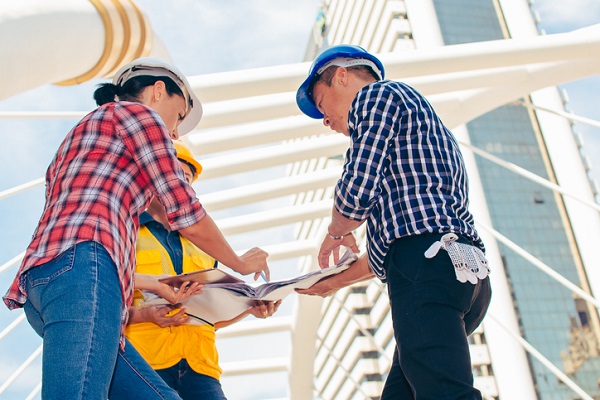Building resilience – Standards Australia November 2020 update

Providing the building and construction industry with safe and practical guidance is a top priority for Standards Australia. The past few months has seen our organisation focus on developing core standards for the sector, while also exploring and developing innovative solutions in dealing with the challenges presented by COVID-19.
A to Z Dictionary of building and plumbing terms
Across the construction and plumbing sectors, there are a range of different definitions for similar products and tools, and at times this can cause confusion and a lack of clarity for workers. Addressing these concerns, Standards Australia, in partnership with the Australian Building Codes Board (ABCB) has launched the National Dictionary of Building & Plumbing Terms (www.constructiondictionary.com.au).
The website enables individuals to search for definitions used in the National Construction Code (NCC), Australian (and joint AS/NZS) Standards and Handbook 50:2004, Glossary of building terms. The website aims to highlight different ways of describing the same or similar terms or processes and provides a general hierarchy of results to assist interpretation.
As definitions change and consolidate in the future, Standards Australia is committed to continued collaboration with both the building and plumbing sector to update and refine the website.
Fire detection guidance
Many of us recognise the high-pitched ringing that comes from smoke alarms; however, this sound can go unheard by those living with hearing impairments.
AS 1603.17:2020, Automatic fire detection and alarm systems, Part 17: Warning equipment for people with hearing impairment provides tests method and requirements for devices like vibrating pads and visual alarm devices. The guidance was updated and released in June 2020, outlining the requirements of devices that can act in conjunction with smoke alarms to alert people with hearing impairment to potential danger.
Alongside AS 1603.17:2020, June saw the publication of two other fire detection standards including:
- AS 4428.3:2020, Fire detection, warning, control and intercom systems – Control and indicating equipment, Part 3: Fire brigade panel
- AS 4428.16:2020, Fire detection, warning, control and intercom systems – Control and indicating equipment, Part 16: Emergency warning control and indicating equipment
These standards specify requirements and performance criteria for emergency warning control systems and are examples of the ongoing work Standards Australia is doing with industry to keep communities effectively alerted to potential fire hazards.
Building preparation
COVID-19 restrictions have been impacting each state and territory differently and with some offices going in and out of lockdown, it is crucial building managers are flushing out systems thoroughly before occupants return.
The AS/NZS 3666 series, Air-handling and water systems of buildings – Microbial control, provides guidance for building managers to flush out their ventilating and cooling (HVAC) systems from potentially dangerous mould, microbial growth and corrosion.
As more and more businesses are allowing employees to return to the office, the value of the AS/NZS 3666 standard series can be an essential tool in assisting building managers and owners to properly flush out their systems and get buildings prepared for the return of thousands of employees. For further guidance, be sure to purchase the full version of the AS/NZS 3666 standard series.
Lifts, escalators and moving walks
Equally important to keeping the safety of buildings for returning customers and workers is ensuring accessibility for the whole community. To support this, Standards Australia has recently published AS 1735.12:2020, Lifts, escalators and moving walks, Part 12: Facilities for persons with disabilities, (an Australian modification of European Standard, EN 81-70:2018).
The standard specifies the minimum requirements for the safe and independent access and use of lifts, escalators and moving walks for people living with disabilities, and is a critical feature in developing buildings that are open and available to people with a disability.
Pull out box: Smarter communities
From regional townships to bustling metropolitan hubs, our towns and cities are becoming more connected. The development of smart cities and communities involve a range of sectors, including the construction and building industry. To help support future smart city projects, Standards Australia has recently published the Smart Cities Roadmap (https://www.standards.org.au/news/on-the-road-to-safe,-sustainable-and-smart-cities).
The roadmap aims to give Australian governments and other organisations a set of clear and actionable recommendations that will assist Australia in developing safe, sustainable and resilient infrastructure for smart cities and communities.
User friendly public commenting platform
Designed to make public commenting easier and simpler for both commenters and committees, Standards Australia has launched a new public commenting platform through our contributor portal, Connect.
A range of updates and additions provides an open, transparent and interactive public commenting platform to improve and automate the public comment and resolution process.
The upgraded platform includes:
- A new and improved navigation system
- Ability to read and endorse comments left by other contributors
- Informs individuals if their comment(s) have been accepted by the committee before publication, and allows for comments on international standards proposed for adoption in Australia.
Building on guidance
As we move into the new year, Standards Australia is looking forward to continued engagement with the sector to provide the necessary standards solutions. The call to action to industry and government leaders is to come forward and engage with Standards Australia to help realise the opportunities so that the whole of Australia benefits.
